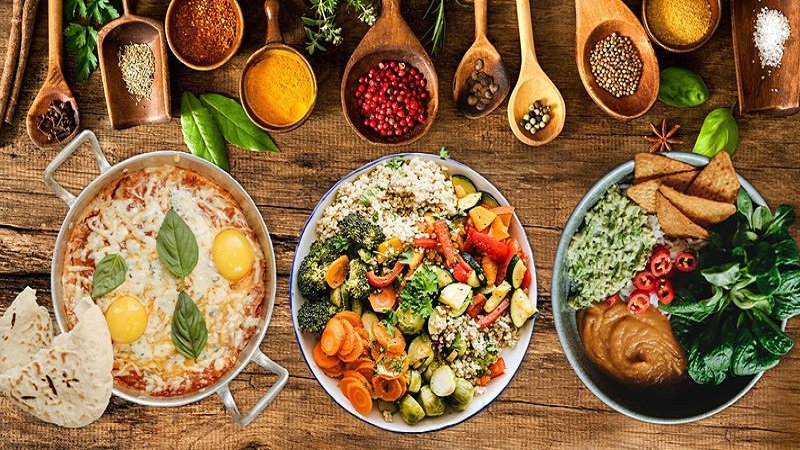Food & Drink
Exploring the Staple Foods of the major African Regions : A Culinary Journey
Introduction to African Cuisine and Staple Foods.
African cuisine is a testament to the continent’s rich diversity, deeply rooted in centuries of tradition, culture, and history. From the aromatic spices of North Africa to the hearty stews of West Africa, each region boasts a distinctive culinary identity that reflects its unique landscape and heritage. This vast culinary tapestry is woven together by staple foods, which form the backbone of daily nourishment across the continent.
Staple foods are fundamental to the diets of African communities, serving as primary sources of energy and nutrition. These staples often include grains, tubers, and legumes, such as maize, millet, sorghum, cassava, and beans. They are typically complemented by locally available vegetables, fruits, and proteins, creating balanced and hearty meals that sustain millions of people.
The significance of staple foods extends beyond mere sustenance; they are integral to the social and cultural fabric of African societies. Meal preparation and consumption are communal activities that bring families and communities together, fostering a sense of unity and shared identity. Traditional recipes and cooking methods are passed down through generations, preserving the culinary heritage and embodying the resilience and resourcefulness of African people.
This blog post aims to take readers on a culinary journey through the staple foods of all 54 African countries. By exploring the diverse array of ingredients and dishes, we hope to offer a glimpse into the rich tapestry of African cuisine. Each section will delve into the staple foods of a specific country, accompanied by vivid images to enhance the visual experience. Whether you are a culinary enthusiast or simply curious about global food cultures, this journey promises to be both educational and inspiring, highlighting the flavors and stories that make African cuisine truly extraordinary.
North Africa: A Blend of Mediterranean and Berber Flavors.
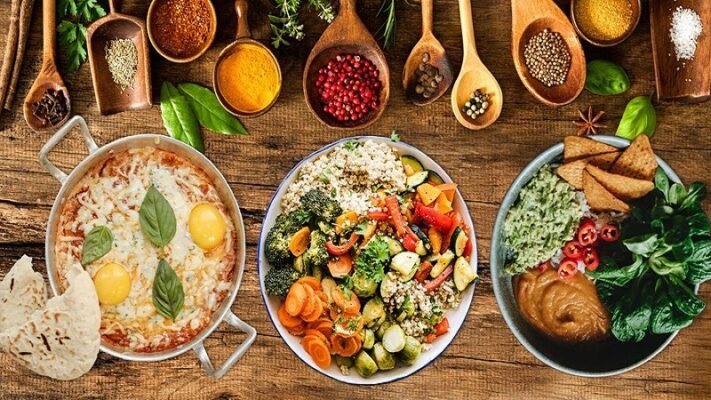
The culinary landscape of North Africa is a vibrant tapestry woven from Mediterranean and Berber influences, creating a unique and diverse array of staple foods. Each country in this region, including Egypt, Libya, Tunisia, Algeria, and Morocco, boasts a rich food heritage that is both distinct and interwoven with common threads.
One of the most iconic staples in North African cuisine is couscous. This versatile, steamed semolina dish serves as a base for numerous meals across the region. In Morocco, couscous is often paired with a variety of meats and vegetables, creating a hearty and flavorful dish. In Tunisia, it might be spiced with harissa, a fiery chili paste, adding a distinctive kick to the meal.
Tagine, another staple, reflects the Berber influence on North African cuisine. Named after the earthenware pot in which it is slow-cooked, this dish combines meat, vegetables, and a melange of spices such as cumin, coriander, and cinnamon. The slow-cooking method allows the flavors to meld beautifully, resulting in a richly aromatic and tender dish. Moroccan lamb tagine with apricots and almonds is a classic example, showcasing the region’s penchant for combining sweet and savory elements.
In Egypt, ful medames is a beloved staple. This simple yet satisfying dish made from fava beans, olive oil, garlic, and lemon juice is traditionally eaten for breakfast but can be enjoyed at any time of the day. Its roots can be traced back to ancient Egypt, highlighting the enduring nature of certain culinary traditions.
Libya’s culinary contributions include bazin, a unique dish made from barley flour dough, shaped into a dome, and served with lamb stew and a spicy tomato sauce. This dish reflects the resourcefulness of Libyan cuisine, utilizing available ingredients in innovative ways.
Algerian cuisine often features chorba, a hearty soup made with lamb, vegetables, and spices, reflecting both Mediterranean and Berber influences. This dish is particularly popular during Ramadan, highlighting its cultural significance.
The culinary traditions of North Africa are a testament to the region’s history and cultural diversity. The blend of Mediterranean and Berber influences has resulted in a rich and varied food culture that continues to evolve while honoring its roots.
West Africa: A Rich Tapestry of Flavors and Ingredients.
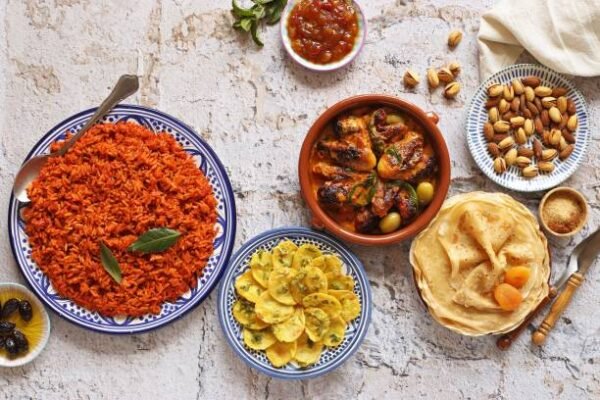
West African cuisine is a vibrant and diverse tapestry, embodying the unique cultural heritage of countries like Nigeria, Ghana, Senegal, and Côte d’Ivoire. Central to this region’s culinary identity are staple foods that have become emblematic of its rich gastronomic tradition. Among these, jollof rice stands out as a quintessential dish, loved for its rich tomato base and a harmonious blend of spices. Each country has its own variation of jollof rice, making it a subject of friendly competition and pride.
Another cornerstone of West African cuisine is fufu, a starchy side dish made from cassava, yams, or plantains. This versatile dish is typically served alongside a variety of soups and stews, such as groundnut stew—a hearty, flavorful dish made from peanuts, tomatoes, and a medley of vegetables and meats. The combination of fufu with these stews exemplifies the region’s emphasis on balanced, wholesome meals.
Local ingredients play a pivotal role in defining the culinary landscape of West Africa. Yams, for instance, are a staple that can be boiled, fried, or pounded to make fufu. Plantains, another versatile ingredient, are often fried into crispy snacks, boiled as a side dish, or mashed to complement main courses. Peanuts, or groundnuts, are not only used in groundnut stew but also serve as a base for sauces and snacks, showcasing their integral role in the local diet.
The intricate use of these ingredients, combined with traditional cooking methods, creates a distinctive culinary identity for West Africa. The region’s flavors are bold and intricate, a reflection of the rich cultural and historical influences that have shaped its cuisine over centuries. Through dishes like jollof rice, fufu, and groundnut stew, West African food offers a sensory journey that is as diverse as it is delicious.
East Africa: A Fusion of Local and Exotic Influences.
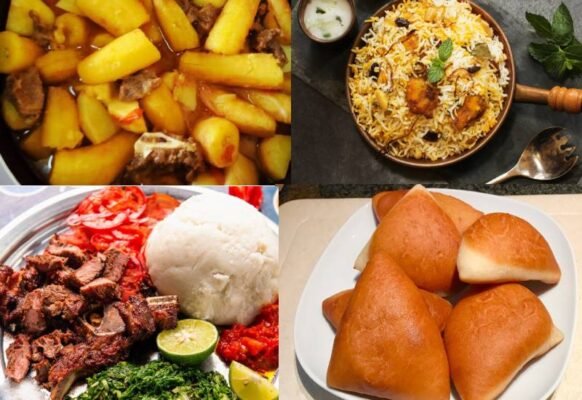

East Africa’s culinary landscape is a rich tapestry woven from local traditions and the influences of Indian and Arab traders who once traversed the region. Each country within East Africa boasts distinct staple foods that reflect this unique blend, offering a diverse and flavorful culinary experience.
In Kenya, ugali stands as a cornerstone of daily meals. This simple yet versatile dish made from maize flour is often paired with sukuma wiki (collard greens) or nyama choma (grilled meat). Ugali’s dense texture and neutral flavor make it a perfect complement to a variety of sides, making it a beloved staple across the nation.
Meanwhile, Ethiopia introduces the world to injera, a sourdough flatbread with a slightly spongy texture, made from teff flour. Injera is not just a dish but a communal experience, often used as an edible plate for an array of stews and vegetables known as wats. This method of dining underscores the Ethiopian value of community and sharing.
Tanzania offers ugali as well, but it is often enjoyed with a different array of accompaniments, such as mchicha (a spinach-like green) and freshly caught fish from the Indian Ocean. The coastal influence is palpable, bringing a freshness to Tanzanian cuisine that distinguishes it from its neighbors.
In Uganda, the spotlight shines on matoke, a dish made from steamed and mashed plantains. This dish is often served with groundnut sauce or alongside hearty stews, reflecting the country’s rich agricultural heritage. Matoke is not just a meal but a cultural emblem, deeply rooted in Ugandan traditions.
The influence of Indian and Arab traders is evident in the widespread use of spices and herbs across East Africa. Cardamom, cloves, and cinnamon make frequent appearances in dishes, adding layers of flavor and complexity. These spices, along with locally grown herbs such as coriander and basil, create a vibrant and aromatic cuisine that is unmistakably East African.
Through these diverse staples and the fusion of external influences, East African cuisine offers a unique and enriching culinary journey, showcasing the region’s history, culture, and agricultural abundance.
“`html
Central Africa: Traditional Foods and Culinary Practices.
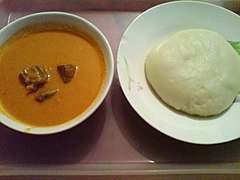
Central Africa is a region rich in culinary diversity, with traditional foods that reflect the area’s abundant natural resources and cultural heritage. The Democratic Republic of Congo, Cameroon, and Gabon, among others, showcase a variety of staple foods such as cassava, plantains, and fish stews. These ingredients form the backbone of many Central African dishes, providing both sustenance and a connection to ancestral traditions.
Cassava, known locally as manioc, is a fundamental staple food in Central Africa. It is incredibly versatile, used in various forms including boiled, fried, or ground into flour to create fufu, a dough-like dish that accompanies many meals. Cassava’s resilience in diverse environmental conditions makes it a reliable food source, deeply embedded in the local diet.
Plantains are another cornerstone of Central African cuisine. Often mistaken for bananas, plantains are starchier and less sweet, making them ideal for cooking. They can be fried, boiled, or mashed, and are often served as a side dish or incorporated into stews. Plantains’ versatility and availability make them a cherished component of daily meals.
Fish stews are prevalent across Central Africa, reflecting the region’s proximity to rivers and lakes. Freshwater fish such as tilapia and catfish are commonly used, combined with ingredients like tomatoes, onions, and local spices to create rich, flavorful stews. These dishes are often slow-cooked, allowing the flavors to meld together, resulting in a comforting and nourishing meal.
Traditional cooking methods in Central Africa emphasize simplicity and resourcefulness. Open-fire cooking remains common, imbuing dishes with a distinct smoky flavor. Communal eating is deeply ingrained in the culture, with meals often shared in a communal bowl, reinforcing social bonds and fostering a sense of community. This practice highlights the importance of food not just as sustenance, but as a means of bringing people together.
Southern Africa: Diverse Flavors from Land and Sea.

Southern Africa boasts a rich tapestry of culinary traditions, heavily influenced by its diverse cultures and landscapes. The staple foods here reflect a harmonious blend of indigenous ingredients and techniques, alongside European and Indian culinary influences. This fusion has given rise to a vibrant food culture that is both unique and deeply rooted in the region’s history.
One of the most ubiquitous staples across Southern Africa is maize porridge, known locally as pap in South Africa and sadza in Zimbabwe. This simple yet hearty dish is a cornerstone of daily meals, often paired with a variety of accompaniments such as vegetables, meat stews, or even spicy relishes. Its versatility and affordability make it an essential part of the diet for many households.
In South Africa, another beloved staple is biltong, a dried and cured meat similar to beef jerky. Originating from the need to preserve meat in the arid climate, biltong has evolved into a popular snack enjoyed by people of all ages. The preparation methods and seasoning can vary, but traditional recipes often include a mixture of vinegar, salt, coriander, and black pepper, which imbues the meat with a distinctive flavor.
Namibia and Botswana share a culinary affinity for game meat, reflecting the region’s vast savannas and wildlife. Dishes like seswaa in Botswana—a slow-cooked, shredded beef or goat stew—highlight the importance of meat in the local diet. The emphasis on simple, robust flavors showcases the natural taste of the ingredients, often enhanced with minimal seasoning.
Southern Africa’s extensive coastline also offers a bounty of seafood, which plays a significant role in the culinary traditions of coastal communities. In Namibia, fresh fish such as hake and snoek are commonly grilled or smoked, providing a nutritious and flavorful complement to maize-based dishes. The coastal influences extend into the use of spices and seasonings, reflecting a blend of indigenous and foreign culinary practices.
The culinary landscape of Southern Africa is further enriched by the contributions of Indian and European settlers. Dishes such as bunny chow—a hollowed-out loaf of bread filled with curry—exemplify the melding of Indian spices with local ingredients. Similarly, the legacy of Dutch and British colonialism is evident in the prevalence of dishes like boerewors (a type of sausage) and bobotie (a spiced meat casserole with an egg-based topping).
In summary, the staple foods of Southern Africa are a testament to the region’s cultural diversity and historical influences. From the ubiquitous maize porridge to the flavorful biltong and the bounteous seafood, these dishes offer a glimpse into the rich and varied culinary heritage of this part of the continent.
Island Nations: Unique Culinary Traditions of Africa’s Islands
The African island nations of Madagascar, Seychelles, Mauritius, and Cape Verde each boast a diverse culinary tradition, deeply influenced by their unique geographical locations and historical encounters. These islands are melting pots of African, Asian, and European flavors, creating a rich tapestry of staple foods that reflect their multifaceted heritage.
In Madagascar, rice is the cornerstone of daily meals. This staple is often accompanied by laoka, a term for side dishes that can include a variety of meats, vegetables, or seafood. Cassava also plays a significant role, featuring in dishes such as ravitoto, where cassava leaves are pounded and cooked with meat. The influence of Asian cuisine is evident in the use of spices and techniques, while French colonization has left a mark with dishes like romazava, a traditional beef and leafy green stew.
Seychelles, an archipelago in the Indian Ocean, showcases a vibrant culinary scene where seafood reigns supreme. Fish, octopus, and other marine delights are commonly prepared in coconut milk-based stews, such as kari koko. The Seychellois cuisine also features boudin, a blood sausage of French origin, and ladob, a dessert made from plantains or cassava cooked in coconut milk. Indian and Chinese influences are evident in the widespread use of spices like curry and ginger.
Mauritius presents an eclectic mix of African, Indian, Chinese, and French culinary traditions. Rice and bread are staples, often served with curries, chutneys, and pickles. The island is famous for its street food, such as dholl puri, a type of flatbread filled with ground yellow split peas, and gajak, deep-fried snacks that reflect Indian influences. The diverse gastronomic scene showcases the harmonious blend of different cultures.
Cape Verde, located off the northwest coast of Africa, offers staple foods largely influenced by Portuguese cuisine. Corn and beans are fundamental, often combined in cachupa, a hearty stew considered the national dish. Seafood is also prevalent, given the island’s coastal geography. The use of spices and herbs reflects African influences, while techniques and flavor profiles often draw from European culinary traditions.
Across these island nations, the convergence of various cultural influences has resulted in distinctive and flavorful cuisines. The staple foods of these islands not only sustain their populations but also narrate a rich history of migration, trade, and adaptation.
Conclusion: The Importance of Staple Foods in African Culture and Identity
The exploration of staple foods across all 54 African countries reveals a profound tapestry of culinary traditions that are deeply intertwined with cultural identity and nutrition. These staple foods, from the ubiquitous maize in Southern Africa to the rich stews of West Africa, are not merely sustenance but embody the history, geography, and social fabric of their respective regions. Each dish tells a story of resilience, creativity, and adaptation, reflecting the diverse climates and ecosystems that shape the African continent.
The cultural significance of staple foods in Africa cannot be overstated. They are at the heart of communal gatherings, rituals, and celebrations, functioning as a medium through which cultural knowledge is passed down through generations. For example, the preparation of injera in Ethiopia or the communal cooking of jollof rice in Nigeria are rituals that foster a sense of community and belonging. These foods also serve as cultural markers that distinguish one ethnic group from another, highlighting the rich mosaic of identities within African nations.
Nutritionally, staple foods play a critical role in the diets of millions of Africans. They are often rich in essential nutrients and are adapted to local agricultural conditions, ensuring food security in many regions. For instance, cassava and plantains are drought-resistant crops that provide vital carbohydrates and sustenance in regions prone to food scarcity. The balanced diet provided by these staples, often complemented by legumes, vegetables, and proteins, underpins the health and well-being of African populations.
This culinary journey through Africa’s staple foods invites us to appreciate the continent’s rich gastronomic heritage. It encourages us to explore these dishes, whether by cooking them at home or seeking them out in local restaurants, thereby fostering a deeper understanding and appreciation of African culture. We invite you, our readers, to share your own experiences and favorite African dishes in the comments below, contributing to the celebration of the rich and diverse culinary traditions that define Africa.

